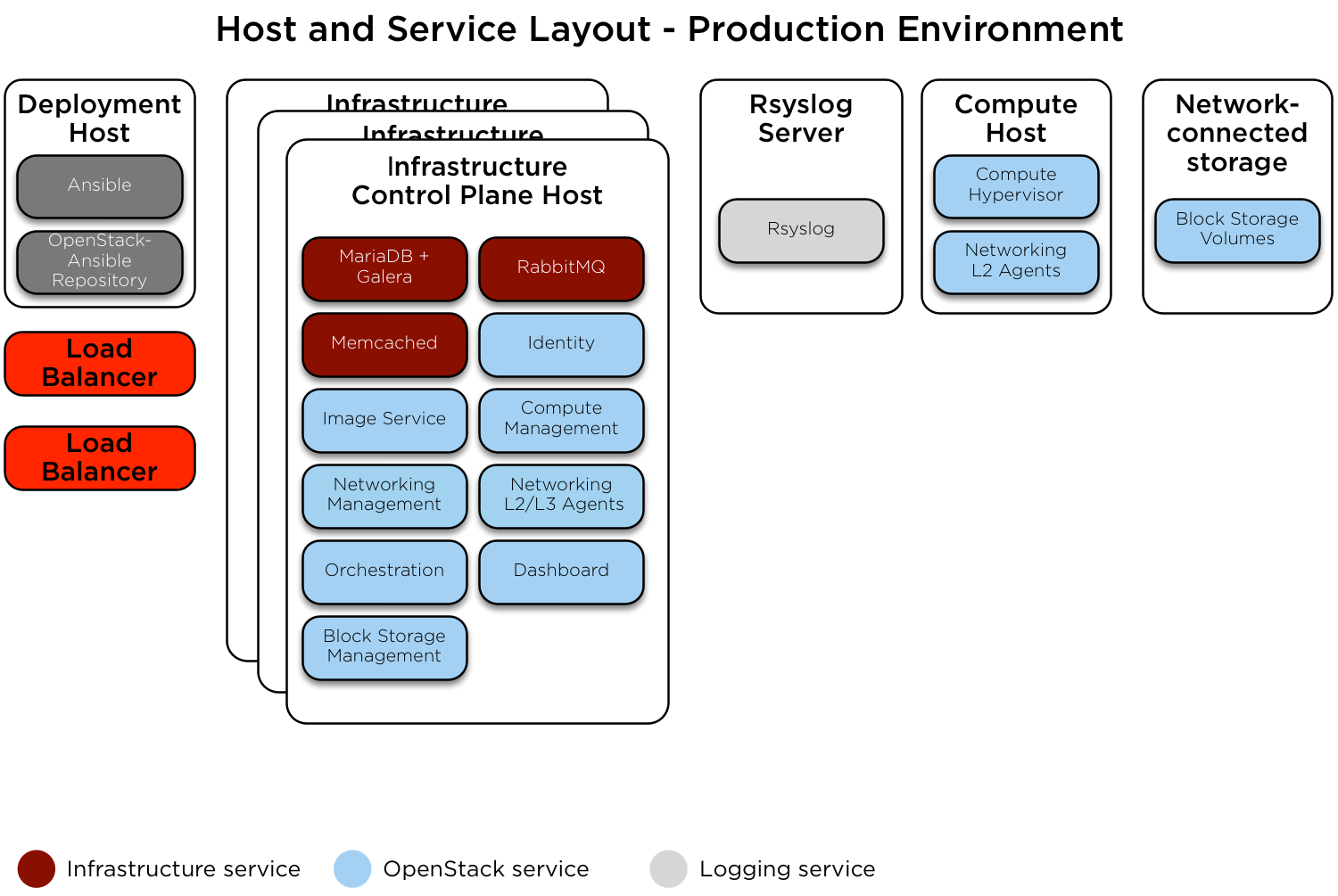The main purpose of that patch is to allow creation of "virtual" container_skel, that will not generate any containers in inventory, but will contain all containers of corresponsive hosts. That might be useful in usecases like AZs, or when deployer simply wants to create custom groups and include all bare metal hosts along with all containers on them to the same group. Such behaviour can be triggered when empty belongs_to is provided for container_skel along with is_nest property. Then container_skel item will contain host-containers and it's children. Change-Id: Ic5570bfe9f0f54d1ea1e067834c11e6c390a2686
7.3 KiB
Routed environment example
This section describes an example production environment for a working OpenStack-Ansible (OSA) deployment with high availability services where provider networks and connectivity between physical machines are routed (layer 3).
This example environment has the following characteristics:
- Three infrastructure (control plane) hosts
- Two compute hosts
- One NFS storage device
- One log aggregation host
- Multiple Network Interface Cards (NIC) configured as bonded pairs for each host
- Full compute kit with the Telemetry service (ceilometer) included, with NFS configured as a storage backend for the Image (glance), and Block Storage (cinder) services
- Static routes are added to allow communication between the Management, Tunnel, and Storage Networks of each pod. The gateway address is the first usable address within each network's subnet.
Network configuration
Network CIDR/VLAN assignments
The following CIDR assignments are used for this environment.
| Network | CIDR | VLAN |
|---|---|---|
| POD 1 Management Network | 172.29.236.0/24 |
|
| POD 1 Tunnel (VXLAN) Network | 172.29.237.0/24 |
|
| POD 1 Storage Network | 172.29.238.0/24 |
|
| POD 2 Management Network | 172.29.239.0/24 |
|
| POD 2 Tunnel (VXLAN) Network | 172.29.240.0/24 |
|
| POD 2 Storage Network | 172.29.241.0/24 |
|
| POD 3 Management Network | 172.29.242.0/24 |
|
| POD 3 Tunnel (VXLAN) Network | 172.29.243.0/24 |
|
| POD 3 Storage Network | 172.29.244.0/24 |
|
| POD 4 Management Network | 172.29.245.0/24 |
|
| POD 4 Tunnel (VXLAN) Network | 172.29.246.0/24 |
|
| POD 4 Storage Network | 172.29.247.0/24 |
|
IP assignments
The following host name and IP address assignments are used for this environment.
| Host name | Management IP | Tunnel (VxLAN) IP | Storage IP |
|---|---|---|---|
| lb_vip_address | 172.29.236.9 | ||
| infra1 | 172.29.236.10 | 172.29.237.10 | |
| infra2 | 172.29.239.10 | 172.29.240.10 | |
| infra3 | 172.29.242.10 | 172.29.243.10 | |
| log1 | 172.29.236.11 | ||
| NFS Storage | 172.29.244.15 | ||
| compute1 | 172.29.245.10 | 172.29.246.10 | 172.29.247.10 |
| compute2 | 172.29.245.11 | 172.29.246.11 | 172.29.247.11 |
Host network configuration
Each host will require the correct network bridges to be implemented.
The following is the /etc/network/interfaces file for
infra1.
Note
If your environment does not have eth0, but instead has
p1p1 or some other interface name, ensure that all
references to eth0 in all configuration files are replaced
with the appropriate name. The same applies to additional network
interfaces.
../../../../etc/network/interfaces.d/openstack_interface.cfg.pod.example
Deployment configuration
Environment layout
The /etc/openstack_deploy/openstack_user_config.yml file
defines the environment layout.
For each pod, a group will need to be defined containing all hosts within that pod.
Within defined provider networks, address_prefix is used
to override the prefix of the key added to each host that contains IP
address information. This should usually be one of either
container, tunnel, or storage.
reference_group contains the name of a defined pod group
and is used to limit the scope of each provider network to that
group.
Static routes are added to allow communication of provider networks between pods.
The following configuration describes the layout for this environment.
../../../../etc/openstack_deploy/openstack_user_config.yml.pod.example
Environment customizations
The optionally deployed files in
/etc/openstack_deploy/env.d allow the customization of
Ansible groups. This allows the deployer to set whether the services
will run in a container (the default), or on the host (on metal).
For this environment, the cinder-volume runs in a
container on the infrastructure hosts. To achieve this, implement
/etc/openstack_deploy/env.d/cinder.yml with the following
content:
../../../../etc/openstack_deploy/env.d/cinder-volume.yml.container.example
You can also declare a custom group for each pod that will also include all containers from hosts that belong to this pod. This might be handy if you want to define some variable for all hosts in the pod using group_variables.
For that create /etc/openstack_deploy/env.d/pod.yml with
the following content:
../../../../etc/openstack_deploy/env.d/pods.yml.example
Above example will create following groups:
podN_hostswhich will contain only bare metal nodes
podN_containersthat will contain all containers that are spawned onbare metal nodes, that are part of the pod.
podN_allthat will contain podN_hosts and podN_containers members
User variables
The /etc/openstack_deploy/user_variables.yml file
defines the global overrides for the default variables.
For this environment, implement the load balancer on the
infrastructure hosts. Ensure that keepalived is also configured with
HAProxy in /etc/openstack_deploy/user_variables.yml with
the following content.
../../../../etc/openstack_deploy/user_variables.yml.prod.example
